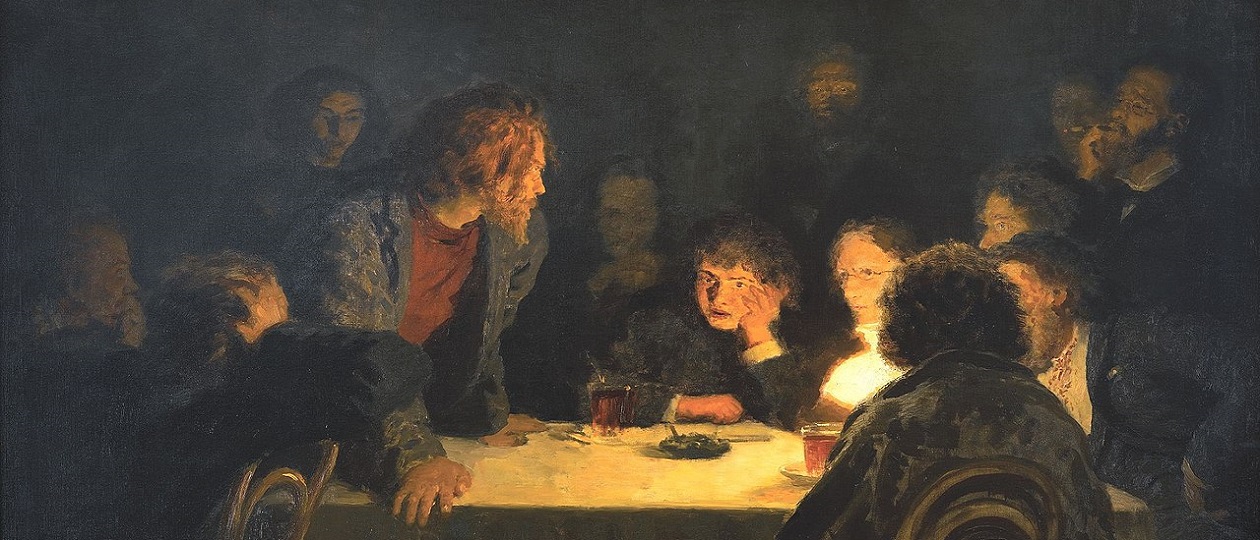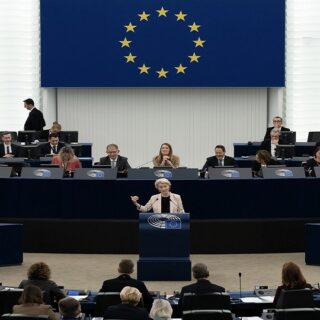
Terrorism became a regular feature of political life in the Russian Empire between 1901-1911.
The first outbreak of terrorism in the 20th century began on February 27, 1901 (old calendar) with the assassination of Education Minister N. P. Bogolepov by the revolutionary P. V. Karpovich and ended on September 1, 1911 with the assassination of Prime Minister P. A. Stolypin by the revolutionary and police agent D. G. Bogrov.
This decade was the third stage in the history of political terrorism in the Russian Empire. The first two stages included:
- A preliminary stage from 1866-1869: the major acts of terrorism were D. V. Karakozov’s (a member of the group Organization, led by N. A. Ishutin) attempted assassination of the tsar on April 4, 1866, and the murder in November, 1869 of student I. I. Ivanov by S. G. Nechaev and members of the group The People’s Vengeance.
- The first wave of terrorism from 1878-1894. The People’s Will ((Народная Воля) was the dominant terrorist organization. The Narodovol’tsy (members of the People’s Will) assassinated Tsar Alexander II on March 1, 1881)
The second wave of terrorism from 1901-1911 set a European-wide record in sheer massiveness and continuity of terrorism.
The Number of Victims of Terrorism
The history of political terrorism in Russia between 1866-1911 coincided with the European <<Era of Dynamite>> between 1870-1914 when anarchists and nationalists killed many people. Anarchists, generally in Spain, Italy and France, assassinated monarchs, presidents, prominent state figures and ordinary people and considered terrorism a form of “propaganda by the deed”. Nationalist terrorists, seeking autonomy or independence, generally operated in Ireland, the Balkans, and the Ottoman Empire.
Dutch researcher Beatrice De Graaf calculated that anarchists between 1880-1914 killed 160 people and wounded more than 500 people in Europe and the United States. [1, p. 144] Even more people were victims of nationalist terrorism, especially in the Balkans. For example, the population of Macedonia was only three million people in 1903. In 1907, British diplomats reported that there were 1,370 cases of violent deaths in Macedonia—four each day. [2, p. 309]
Terrorism in the Russian Empire between 1860 and 1900 took the lives of about 100 people, including Tsar Alexander II in 1881. [3, p. 3]. These numbers appear insignificant compared to the number of victims of terrorism between 1901-1911.
American historian Anna Geifman gave the following calculations on the massiveness of terrorism. Between October 1905 to the end of 1907, the number of government representatives—both civilian and military—reached 4,500. Victims from the general population included 2,180 killed and 2,530 wounded. The total number of victims was more than 9,000. Between January 1908-May 1910, the government recorded 19,957 terrorist acts and revolutionary robberies–<<expropriations>>. The dead included 732 government persons and 3,051 private persons and the wounded included 1,022 government persons and 2,829 private persons. The number of victims was 7,634. Geifman estimated that the total number of victims of revolutionary terrorism between 1901-1911 was about 17,000. [3, p. 21]
The timing and continuity of terrorism in Russia during these years need to be addressed. Terrorism spiraled after Tsar Nicholas II proclaimed the Manifesto of October 17, 1905. The October Manifesto granted political freedom and the establishment of the State Duma, a parliament. Russia went from being an autocratic (absolutist) state to a semi-autocratic, semi-constitutional state and took a major step toward becoming a European state.
However, many socialists and liberals considered the October Manifesto a sign of weakness on the part of Tsar Nicholas II and concluded that a series of well-aimed blows—terrorist acts and uprisings—could overthrow the government.
Terrorist acts continued after mass protest movements ended in 1906-1907. Although party leaders repeatedly stated that terrorism would only be used in connection with mass violence, terrorism became self-perpetuating. Party leaders could try to suspend or end terrorist operations, but rank-and-file members would continue to engage in terrorism or join groups that practiced unrestrained terrorism. Several factors combined to put an end to terrorism by 1911. These included the general exhaustion of the population from revolutionary upheavals and government repressions. Government reforms such as the granting of a State Duma and the land reforms of Prime Minister Stolypin also removed some of the conditions that enabled the rise of terrorism and mass violence.
A Crowded Playing Field
Terrorism was the result of the strained and tense relationships between the government and educated society, as represented by political parties and movements. One can even describe terrorism as a form of civil war between the government and the political movements. Even parties and movements that did not practice terrorism had to determine their attitudes toward terrorism as a form of political struggle and whether they would support the government in its attempts to end terrorism and other types of mass violence.
While the People’s Will held a virtual monopoly on terrorism in the 19th century, terrorism in the early 20th century represented a crowded playing field of practitioners, supporters, and opponents.
Parties and movements practicing terrorism included:
- Empire-wide socialist parties: the Socialists-Revolutionaries (SRs) who considered themselves the heirs of the People’s Will; the Union of Socialists-Revolutionaries-Maximalists who split from the SR party over the leadership’s decision to suspend terrorism; Social Democrats—both Bolsheviks and Mensheviks—despite the loud criticism of individual terrorism by G. V. Plekhanov, V. I. Zasulich, Yu. O. Martov and V. I. Lenin. In fact, beginning in late 1905, Lenin urged Bolsheviks to practice <<partisan activities>>– a code word for terrorism.
- Anarchist groups and movements of Anarcho-Communists, Anarcho-Syndicalists, and Anarcho-Individualists. Anarchists considered terrorism <<propaganda by the deed>>. Even anarchists opposing terrorism could justify it by describing it as a spontaneous act by the common people. Outside the camp of the socialist parties and anarchists many marginal leftist groups with no party affiliation practiced terrorism. Members of these groups had often quit parties and even anarchist groups because they objected to any restrictions on practicing terrorism.
- National minority Marxist and Populist [Народнические] parties, especially Polish, Jewish, Armenian, and Latvian parties. Many of these parties were affiliated with the empire-wide parties. The major exception among the national minority parties was the right-wing Polish National Worker’s Union under the leadership of the National Democratic Party.
- Black Hundred [черносотенные] fighting squads from the Union of the Russian People and other extreme-right organizations. They killed several liberal Duma deputies. Black Hundred terrorism marked the beginning of right-wing terrorism in Europe in the 20th [4, cc. 120-121]
Political terrorism was overwhelmingly left-wing. However, the emergence of Black Hundred terrorism indicated that far-rightists were convinced that they could only fight leftist terrorism with monarchist and Russian nationalist terrorism. As well, the willingness of some Black Hundreds to take up terrorism shows that they believed that the government was unable to defend itself. This was one more aspect of how the Black Hundred <<revolution from the right>> could be one more threat to stability.
Some Characteristics of Terrorism
Terrorism from 1901-1911 had several distinguishing characteristics.
Despite ideological conflicts between political parties, terrorists from different parties and movements, including the anarchists, often worked together on terrorist operations. They took the view that party leaders, who often lived in emigration, had no right to dictate activity to rank-and-file members who were risking their lives to overthrow the government. In fact, rank-and-file members of the parties and movements often worked together in revolutionary members because they knew that disputes between the leaders tended to antagonize many leftists.
Terrorism took on some specifically ethnic dimensions in Europe’s most multiethnic country. Terrorists from the ethnic minority parties committed terrorist acts against people of other nationalities especially if they came from different social classes. They also committed terrorist acts against members of their own nationality if they suspected them of treason. In the Caucasus, terrorists of all parties and movements adapted terrorism to local traditions and engaged in blood feuds, kidnapping of women and children, burning of crops. [3, p. 25] Fighting squads from the right-wing Polish National Workers’ Union committed terrorist attacks against Russian bureaucrats, including school inspectors, and against Poles considered traitors, especially workers from the socialist parties. Note that already in the 1890s, militants from the Polish Socialist Party conducted terrorist attacks against police informers and strikebreakers. [3, p. 17]
Indiscriminate killing was the major feature of terrorism from 1901-1911. Terrorists conducted political and economic terrorism. Victims of political terrorism included members of the Imperial family, ministers, governors, generals and other high officials, rank-and-file bureaucrats, employees, Orthodox priests and clergy from other denominations, street policemen, soldiers, Cossacks, Black Hundreds and other monarchists, and many innocent bystanders. Victims of economic terrorism included not only nobles and capitalists, but also shopkeepers, street vendors, engineers, technicians, customers in restaurants and cafes and many other ordinary people considered exploiters. According to terrorists, customers in restaurants, cafes and other <<bourgeois>> establishments were guilty of adhering to bourgeois values. Terrorists from all parties and movements practiced “expropriations””—armed robberies of banks, financial institutions, and private individuals to finance revolutionary operations. Robberies often attracted the participation of common criminals who could then claim that they were revolutionaries and obtain the relatively privileged status of political prisoners. Many revolutionaries argued that the participation of common criminals was demoralizing revolutionaries [4, c. 122]
Inevitably, one must ask how the terrorists of the 20th century differed from the People’s Will.
The People’s Will Versus 20th Century Terrorists
Historian Anna Geifman described the terrorists of the 20th century as <<terrorists of a new type>> and argued that they strongly differed from the terrorists of the People’s Will. The terrorists of a new type, in her opinion, especially among the anarchists and marginal left groups, had a low level of ideological and intellectual consciousness, showed little inclination to idealism and loyalty to the cause, and lacked any principles in their tactics and choice of targets for terrorist acts. They attracted many criminals, psychologically unstable people, teenagers, and even children, to engage in terrorism. [3, pp. 6-8]
In certain respects, Geifman’s arguments are not surprising because many historians still try to <<divorce>> the People’s Will from terrorists of the 1860s and 20th century. As will be shown in future articles, the People’s Will still holds a unique, even honorable, position in the history of world terrorism. Even scholars condemning nearly all terrorist movements, still make an exception for the People’s Will.
However, the history of the People’s Will has many dark pages and the organization is the organic link between the first and third stages of terrorism.
Geifman suggested that the composition of the terrorists of the 20th century strongly distinguished them from the People’s Will. She suggested that the proletarianization of the ranks of the terrorists basically distinguished them from the terrorists of the 19th century who basically came from more privileged strata. Geifman asserted that factory workers, artisans, unqualified workers, and the unemployed made up a huge contingent of the terrorists, especially among the anarchists. [3, p. 11]
However, Geifman then listed other categories of terrorists of the 20th century—women, especially Russian and Jewish, from the middle strata, members of ethnic and religious minorities especially from the Pale of Jewish Settlement [15 western provinces], Poland, the Caucasus, and the Baltic provinces. She suggested that many terrorists from the border regions came from lower social strata and had a low level of education. However, Geifman then noted that terrorism also attracted members of the more privileged strata, including the aristocracy, and many members of educated society, included students and members of different professions. [3, pp. 11-13]
In effect, the terrorists of the 20th century represented a wide array of origins. However, the participation of workers and peasants in terrorist activities simply does not change the intelligentsia nature of political terrorism in Russia. All parties and movements, whether they used terrorism or not, were under the leadership of the intelligentsia.
Furthermore, many former members of the People’s Will participated in terrorist organizations especially those run by the Socialists-Revolutionaries. It appears that they were not aware of any major differences between the People’s Will and the new generation of terrorists. In fact, the terrorists of the 20th century took many of the tactics of the People’s Will to a higher and more massive scale.
The next article will show how the attitudes of Russia’s liberal and conservative parties enabled the massiveness and continuity of terrorism. The criminalization of many political movements across the spectrum was one of the distinguishing features of this wave of terrorism.
Citations
- De Graaf, Beatrice. The Black International Conspiracy as Security Dispositive in the Netherlands, 1880-1900. 2. Historical Social Research / Historische Sozialforschung , 2013, Vol. 38, No. 1 (143), Security and Conspiracy in History, 16th to 21st Century (2013), pp. 142-165.
- Gawrych, George W. The Culture and Politics of Violence in Turkish Society, 1903-14. Middle Eastern Studies, Jul., 1986, Vol. 22, No. 3 (Jul., 1986), pp. 307-330.
- Geifman, Anna. Thou shalt kill: revolutionary terrorism in Russia, 1894-1917. Princeton NJ: Princeton University Press, 1993. Русский перевод в электронной форме. Гейфман, Анна. Революционный террор в России, 1894— 1917. Москва: КРОН-ПРЕСС, 1997. http://royallib.com/book/geyfman_anna/revolyutsionniy_terror_v_rossiihtml
- Рокки, Энтони Карл. Периодизация истории политического терроризма в Российской империи между 1866-1911: элементы преемственности и перемен (Periodization of the history of political terrorism in the Russian Empire between 1861-1911: elements of continuity and change). Гусевские чтения–2023. Три измерения политической истории России: идеология, политика, практика. Москва: ИКД «Зерцало-М»; МГПУ, 2023, сс. 108-124.





